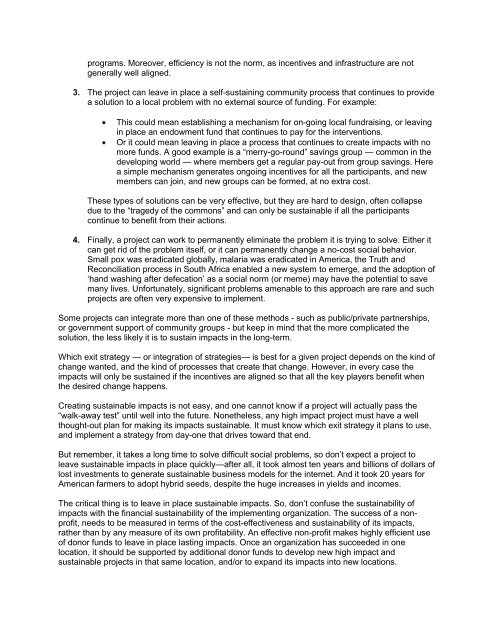Real Good, Not Feel Good. A Brief Guide
Real Good, Not Feel Good. A Brief Guide
Real Good, Not Feel Good. A Brief Guide
You also want an ePaper? Increase the reach of your titles
YUMPU automatically turns print PDFs into web optimized ePapers that Google loves.
programs. Moreover, efficiency is not the norm, as incentives and infrastructure are not<br />
generally well aligned.<br />
3. The project can leave in place a self-sustaining community process that continues to provide<br />
a solution to a local problem with no external source of funding. For example:<br />
This could mean establishing a mechanism for on-going local fundraising, or leaving<br />
in place an endowment fund that continues to pay for the interventions.<br />
Or it could mean leaving in place a process that continues to create impacts with no<br />
more funds. A good example is a ―merry-go-round‖ savings group — common in the<br />
developing world — where members get a regular pay-out from group savings. Here<br />
a simple mechanism generates ongoing incentives for all the participants, and new<br />
members can join, and new groups can be formed, at no extra cost.<br />
These types of solutions can be very effective, but they are hard to design, often collapse<br />
due to the ―tragedy of the commons‖ and can only be sustainable if all the participants<br />
continue to benefit from their actions.<br />
4. Finally, a project can work to permanently eliminate the problem it is trying to solve. Either it<br />
can get rid of the problem itself, or it can permanently change a no-cost social behavior.<br />
Small pox was eradicated globally, malaria was eradicated in America, the Truth and<br />
Reconciliation process in South Africa enabled a new system to emerge, and the adoption of<br />
‗hand washing after defecation‘ as a social norm (or meme) may have the potential to save<br />
many lives. Unfortunately, significant problems amenable to this approach are rare and such<br />
projects are often very expensive to implement.<br />
Some projects can integrate more than one of these methods - such as public/private partnerships,<br />
or government support of community groups - but keep in mind that the more complicated the<br />
solution, the less likely it is to sustain impacts in the long-term.<br />
Which exit strategy — or integration of strategies— is best for a given project depends on the kind of<br />
change wanted, and the kind of processes that create that change. However, in every case the<br />
impacts will only be sustained if the incentives are aligned so that all the key players benefit when<br />
the desired change happens.<br />
Creating sustainable impacts is not easy, and one cannot know if a project will actually pass the<br />
―walk-away test‖ until well into the future. Nonetheless, any high impact project must have a well<br />
thought-out plan for making its impacts sustainable. It must know which exit strategy it plans to use,<br />
and implement a strategy from day-one that drives toward that end.<br />
But remember, it takes a long time to solve difficult social problems, so don‘t expect a project to<br />
leave sustainable impacts in place quickly—after all, it took almost ten years and billions of dollars of<br />
lost investments to generate sustainable business models for the internet. And it took 20 years for<br />
American farmers to adopt hybrid seeds, despite the huge increases in yields and incomes.<br />
The critical thing is to leave in place sustainable impacts. So, don‘t confuse the sustainability of<br />
impacts with the financial sustainability of the implementing organization. The success of a nonprofit,<br />
needs to be measured in terms of the cost-effectiveness and sustainability of its impacts,<br />
rather than by any measure of its own profitability. An effective non-profit makes highly efficient use<br />
of donor funds to leave in place lasting impacts. Once an organization has succeeded in one<br />
location, it should be supported by additional donor funds to develop new high impact and<br />
sustainable projects in that same location, and/or to expand its impacts into new locations.


